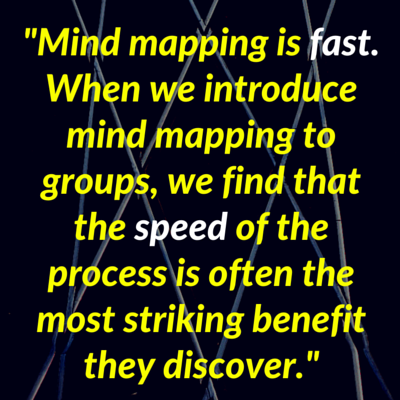In project management, the work breakdown structure (WBS) is a pivotal planning document: It divides the project into phases and displays the tasks required to complete each one. A very effective way to create a WBS is with mind mapping software, which supports all of the steps teams need to follow to plan and execute a successful project.
As you’ll see, mind mapping software can help teams do a more effective and comprehensive job of project planning, spur team involvement and creativity, and can lighten the burden in many ways for overworked project managers.
Here are 12 ways mind mapping software can supercharge creation of a work breakdown structure:
1. Creativity during the project planning process
If you haven’t managed projects before, you may be tempted to assume that project planning is a purely logical exercise. But you would be wrong. Successful project planning also needs to have a creative element, according to a paper entitled Mind Mapping as a WBS Development Tool by Karen A. Brown, Ph.D., PMP and Nancy Lea Hyer, Ph.D., published on the Project Management Institute (PMI) website (free registration is required to view the paper).
“Left-brain or linear thinking may be important for scheduling, resource allocation, and monitoring project progress. However, the early stages of a project require more creative or right-brain thinking… A mind map presents information in a visually stimulating manner and draws on the latent creativity of project team members. As a consequence, it allows a team to generate more ideas and instills involvement.”
But is creativity REALLY necessary during creation of the work breakdown structure? Isn’t linear thinking enough? The paper’s authors say yes:
“Why is creativity necessary in the early stages of project planning? First, there may be more than one way to achieve project goals.”
It’s human nature. We come up with one solution, and naturally assume it’s the best. We simply go with it. But it may be more advantageous to invest more time and consider other possible solutions – one of which may achieve the project goals faster, at a lower cost and with less risk. Mind mapping encourages whole-brained thinking – so it supports both the creative and logical sides of the mind that are needed for successful project planning and execution.
2. It drives greater involvement during the brainstorming process
 In a team planning meeting, a mind map projected on the wall is a catalyst, spurring more ideas than conventional methods of project planning, such as whiteboards and sticky notes. According to professors Brown and Hyer, it also tends to naturally draw out quiet people, who otherwise may be intimidated to write an idea on a flipchart or whiteboard.
In a team planning meeting, a mind map projected on the wall is a catalyst, spurring more ideas than conventional methods of project planning, such as whiteboards and sticky notes. According to professors Brown and Hyer, it also tends to naturally draw out quiet people, who otherwise may be intimidated to write an idea on a flipchart or whiteboard.
“The early stages of project planning call for creativity and team involvement—mind mapping provides the stimulus for both.”
A side benefit of these factors is speed. Mind mapping enables teams to generate a more comprehensive work breakdown structure, faster:
“Mind mapping is fast. When we introduce mind mapping to groups, we find that the speed of the process is often the most striking benefit that they discover. They are amazed at how little time it can take to generate a first pass at a WBS. For a project of moderate size, they can develop an initial framework and a relative amount of detail in just 20 to 30 minutes.”
3. Mind maps encourage greater consensus and “buy in”
Mind maps spur greater discussion during team planning meetings, ensuring a higher degree of “buy in” and support for the project. That’s critical, because if team members don’t feel a sense of ownership in the project, they will be unlikely to fully support it during project execution. Such passive resistance can undermine even the best-planned projects.
“Mind mapping engages the team and generates enthusiasm for the project,” the paper’s authors report. They have used it in hundreds of settings, and find it to be very effective. They also report that mind mapping also gives team members a better grasp of the bigger picture, which often gets lost as teams wade their way through the details of the project planning process. The better they understand the purpose and thinking behind the project, the more likely they are to support it.”
4. Avoid getting “lost in the weeds” too early in the planning process
Without a tool like a mind map to bring both creativity and structure to the work breakdown structure, teams can too quickly get mired in entering tasks into a GANTT chart or project management software. Preoccupied with minutiae and the tools, they may miss valuable details that need to be included in the plan. Mind mapping software, with its ability to expand and collapse topic branches, is ideal for giving teams a clear idea of the bigger picture as well as for digging down into the details.
5. More complete planning means fewer problems later
Most project managers have experienced this uncomfortable scenario: During the project planning process, a key area was overlooked. Incorporating it into the project’s current status inevitably results in delays, scope creep and cost overruns – and some unhappy stakeholders!
The visual design of a WBS mind map makes it easy to see how all of the information it contains is related. You can more easily identify what’s missing and where greater clarification or more information is needed. As a result, professional project managers agree that mind maps result in a more complete picture of people, priorities, challenges and risks.
6. Makes idea organization easier
Typically, after a team has generated a complete first draft of a WBS mind map, one or more project leaders analyze, consolidate, and organize the ideas they contain. As the paper points out, this is an analytical task that does not lend itself well to group interaction. After that, the full team reconvenes to review the results of this synthesized version of the WBS.
“The second round of group discussion about the WBS will allow for clarification and reinforce team buy-in, but it is also likely to generate additional ideas to add to the map,” the authors explain. Because of the mind map’s radial structure, new ideas are easily accommodated and integrated into its structure.
7. It facilitates risk management
As with any business plan, there is always a certain degree of uncertainty when formulating a project plan. Using the WBS mind map, the team can take steps to identify potential risks and mitigate them:
“Early in the planning project, a team should consider possible risks and build-in plans for avoiding them, mitigating their consequences, or responding to them. Once the team has gained a big picture perspective on the project through a mapping process, members can step back and ask, ‘Given the scope and content of our plan, what could go wrong?’ Very often, the group decides to modify the mind map, adding or deleting elements from the WBS, based on this analysis.”
Once again, the flexibility of the mind map format makes this fairly easy to do. The team can even perform this risk analysis in a linked sub-map, so they don’t clutter up the WBS map too much. This removes clutter from the main mind map, while still keeping the risk analysis and other supporting information just a single mouse click away.
8. Task assignments are easy
Once the work breakdown structure is complete, the team must turn its attention to identifying tasks that need to be done. Most mind mapping programs easily support this. You can convert topics into tasks and capture start and end dates, priority, milestones and resources (people assigned to the task).
In addition, the project manager can filter the mind map to show only tasks assigned to a specific team member, one at a time. This can help team members better understand what they’re responsible for, and can be useful for resource leveling – making sure tasks are distributed equitably among the team members.
9. Project budgeting
One of the results of more complete WBS design is more accurate budgeting. By brainstorming the project scope in a mind mapping tool, the project manager can easily assign budget and duration estimates to each task. Budget and duration estimates can then be exported into Excel or Project for additional planning and analysis.
10. Streamlined reporting
Five mind mapping programs include integrated GANTT charts. This capability makes it easy to translate tasks from the WBS into a GANTT format. In addition, project data can be exported to a variety of formats, including Microsoft Word, Excel, PowerPoint and Project. This makes it easy to share information with project stakeholders in formats they’re most comfortable with. This eliminates the need to manually re-enter project data in other programs.
11. Identify tasks falling behind schedule
The visual nature of a mind map makes it an ideal tool for at-a-glance monitoring of project progress. The paper recommends a simple color-coding system to make it easy to visually skim the WBS to assess what’s on target, what’s at risk, late and completed:
“The work breakdown structure can… be color coded to represent sub-deliverable (task) status. Assigning colors of red for late, yellow for at risk, green for on-target, and blue for completed deliverables is an effective way to produce a heat-map of project progress and draw management’s attention to key areas of the work breakdown structure.”
I think this is an excellent suggestion! In addition, several mind mapping programs can do conditional formatting. In other words, if a task hasn’t been completed by its due date, it will automatically be formatted in a different color, making it stand out visually.
12. Support for remote collaboration
As teams become more geographically dispersed, mind maps are emerging as an effective tool to enable collaboration with remote team members – during the project planning process and during project execution.
Project planning: A web-based mind mapping tool like MindMeister enables multiple people to simultaneously add to and edit a shared WBS mind map stored in the cloud. Several others link web-based versions of their programs with their desktop software to accomplish the same type of real-time collaboration on mind maps. Chat features enable team members to talk with one another as they contribute to the shared map, enhancing team members’ understanding of its contents.
Project execution: Several developers now offer web- and mobile-based team task management tools, which are integrated with their mind mapping software. This means that even team members who don’t have mind mapping software installed on their computers can view and contribute to project status updates.
Want to learn a simple process to create a work breakdown structure (WBS)? Check out my new online course, How to Use Mind Mapping Software for Project Management – praised by professional project managers and entrepreneurs for its effectiveness!



Leave a Reply